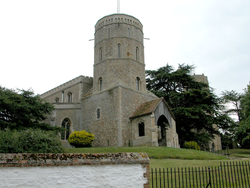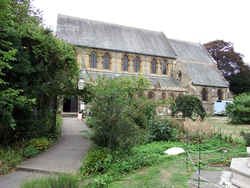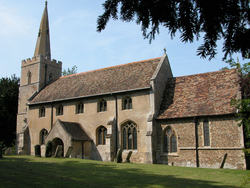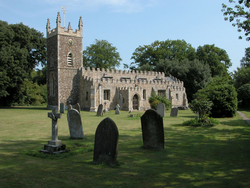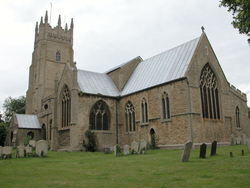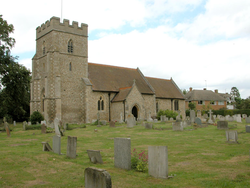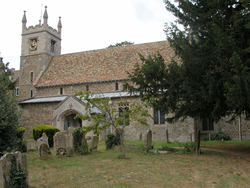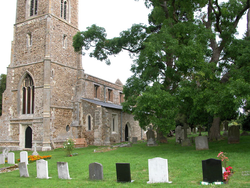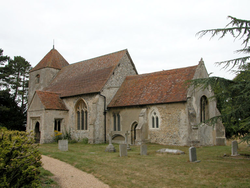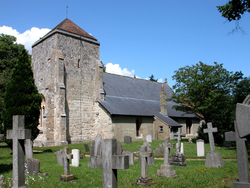
The Corpus of ROMANESQUE SCULPTURE in Britain & Ireland
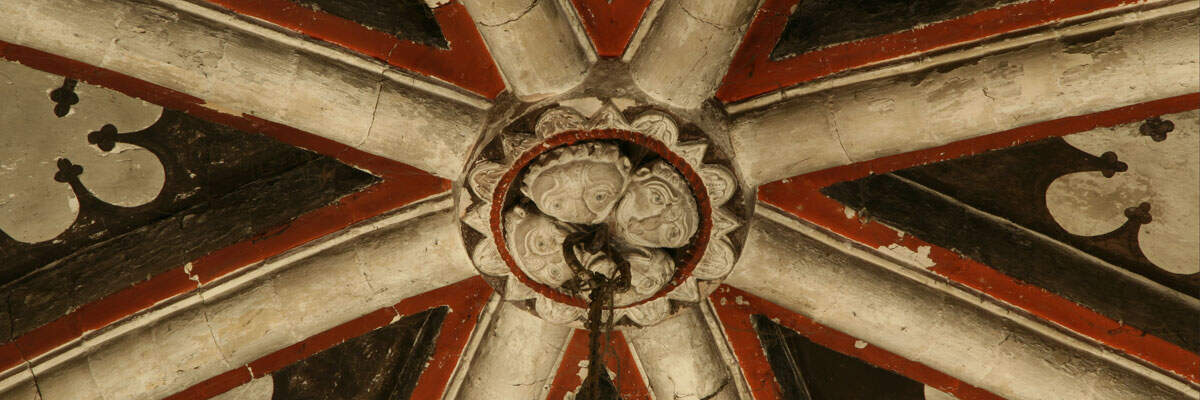
Cambridgeshire (pre-1974 traditional (England and Wales))
Parish church
There are two churches on the same site: S of St Mary's is the redundant later church of SS Cyriac and Julitta. St Mary's has a four bay Perpendicular aisled nave with a clerestorey and an aisleless chancel, largely dating to Sir Arthur Blomfield's restoration of 1878 but with blocked round-headed windows to N and S. All of this is attached to a spectacular 12thc. W tower with a later doorway under a porch. The tower has a square lower storey with plain windows to N and S; an octagonal second storey on squinches with more elaborate 12thc. windows to N, S and W; a 16-sided third storey with pointed lancets; and a 16-sided later fourth storey with a modern parapet, all surmounted by a lead spike. There are string courses between storeys. Inside, the tower is open for the first three storeys, but the lowest has been vaulted at some point and the W side of the tower arch cut away. Construction is of flint and pebble rubble.
Parish church
The present church of St Giles, Castle Street was rebuilt in 1875 to the design of T. H. and F.Healey of Bradford on a site slightly to the N of the medieval church that it replaced. The old church was founded 1092 (see History), and consisted of a nave, chancel, N transept and S porch, to which was added a large N annexe early in the 19thc. This was pulled down when the present church was built, but its chancel arch was re-used at the E end of the S nave aisle, and a doorway, perhaps based on the old S nave doorway but constructed of stones of various periods, was inserted at the E end of the N aisle to serve as the vestry doorway. These two features are described below.
The church of 1875 has a 4-bay aisled nave with clerestoreys. The aisles continue alongside the 2-bay chancel, providing a S chapel and a N vestry.
Parish church
Extremely tall, five-bay nave with
clerestorey, N aisle and N and S porches. Much lower
aisleless chancel and W tower with octagonal stone
spire. The original (lower) nave and the chancel date
from c.1300 and the aisle and tower from the early 14thc. The clerestorey windows are Perpendicular, so the heightening of
the nave presumably dates from this time, but the exterior treatment makes it
difficult to be sure. The chancel and tower are
constructed of pebble rubble, the nave of stone rubble laid disturbingly like
crazy paving. The S side of the nave is mortar rendered. Inside, the
piers of the N arcade are of
Barnack stone and the arches of local clunch. There was a restoration in
1872-74 by J. Morley and J. Christian, and in 1926 the spire, having become
unsafe, was taken down along with the topmost storey of the tower. Rebuilding
was completed in the following year. The only 12thc. feature is the font.
Parish church
The church is of pebble rubble, embattled
following a restoration of 1640 when the chancel was also rebuilt. It has a nave, possibly of the
11thc. (RCHM), with a 14thc. S aisle, a mortar-rendered unaisled
chancel with S vestry and a W
tower. There are assorted architectural mouldings and a piece of a 13thc. grave
slab reset on the exterior of the S and E walls of the S vestry. The only 12thc. sculpture is on a reset window head
in the N nave wall.
Parish church
A cruciform church of c.1200 with aisled nave, transepts and aisleless chancel. The crossing tower was removed and a W tower built to replace it, referred to in 1502 as the novum campanile and probably dating from around that time. The nave clerestorey is also late medieval, as is the chapel added to the N of the chancel. The W crossing arch provides a spectacular display of chevron ornament, and all four crossing arches have carved capitals, as do the nave arcades. It should be said that each crossing arch is supported on half columns, and between adjacent half columns within the crossing space are slender shafts with capitals. The capitals of the major supports differ from one another, and those of the secondary shafts always continue one or other of the designs alongside them, but the system is not really regular enough to say that some of the arches have two orders towards the centre and others have only one. For example, the shafts on the E side of the N and S arches clearly belong to the E crossing arch, while those on the W side belong just as unambiguously to the N and S arches rather than the W arch. In addition it should be noted that orders in the arch never correspond to what is going on in the piers below, and for that reason the arch decoration is always described separately from the piers.
Finally there are plain arches leading from the nave aisles into the transepts.
Parish church
11–12thc. aisleless nave and W tower with 13thc. chancel. A N transept was also added in the 13thc., partially
obscuring an earlier window. Most of the tower is 14thc., along with the tower
arch. There is no spire. Construction is of flint and pebble, the prominently
pointed Victorian restorations being particularly noticeable here. There was a
restoration in 1885 by J. P. St Aubyn, and a complete restoration of the
exterior of the tower c.1990. Features recorded are the N and S nave
doorways, N nave window and font.
Parish church
Five-bay aisled nave with clerestorey and S doorway under a 15thc. porch, aisleless chancel with N
vestry of 1900, W tower. The earliest parts are 12thc.
(the lower storey of the tower). For the rest, the elaborate S doorway is early
13thc. in its structure but 12thc. in its decorative repertoire. This is
described below, but such other early 13thc. features as the tower arch and
nave arcades fall outside the scope of the CRSBI. The
church is of mixed flint, pebble and stone, except for the N aisle, of brick,
which was restored in 1912. Other restorations took place in 1897 and 1899.
Parish church
Nave and aisles of the 13thc. with Perpendicular clerestorey and doorways to N and S, the former with a
porch. Aisleless chancel with
N vestry, and a tall Perpendicular W tower without a
spire. Construction is of rough ashlar rubble and pebbles. The chancel was restored in 1858 and 1875, and in 1885–88
J. P. St Aubyn restored the entire church. As Pevsner comments, "the church
looks almost entirely — except for the Perp W tower — as if it
had been rebuilt". In the S wall of the tower are two reset chevron
voussoirs.
Parish church
The church, largely of flint, stands on a substantial mound, and
consists of an aisleless nave with S porch; a 12thc.
chancel of clunch rubble lengthened in the 16thc.; and
a short two-storey W tower with a pyramid roof. There is a 12thc. window in the
N wall of the chancel.
Parish church
Nave with S aisle rebuilt in brick, rendered chancel and ashlar and flint W tower. Brick boiler house added
to S nave aisle. The chancel was rebuilt in the early
17thc. after a fire, and again in 1777, and there was a restoration in 1870.
Features described are the N nave doorway and the chancel arch.
